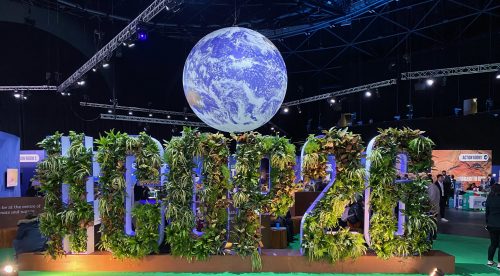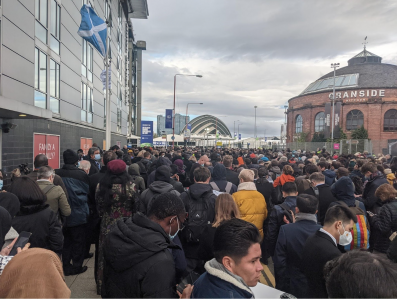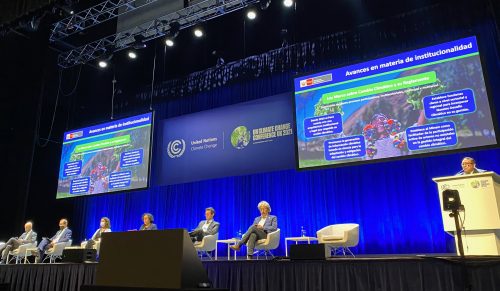
Introduction
During the first two weeks of November, the 26th annual UN Conference of Parties (COP26) took place in Glasgow Scotland. Through support from the UNC Department of Public Policy and the Department of City and Regional Planning Department (DCRP), multiple DCRP students were able to attend as observers. Two of these students reflected on their experiences, considering how their planning education informed their perspective on the events that took place. Pierce Holloway (Masters Candidate) attended the first week of COP26 while Amanda Ullman (PhD student) attended the second week. Their overall understanding of the conference through a planning lens perspective reads below.
Week 1 – Pierce Holloway
 My first interaction with COP26 was one of disorganization and anxious energy. Having arrived on Saturday, two days before the conference started, I went straight to the Scottish Event Campus to obtain my badge in hopes of easing my first day at the conference. I was met with long lines at the conference health center for COVID testing, though after just over an hour I was able to enter the campus and receive my badge. Returning on Monday I, along with other UNC students, were greeted with a great mass of people all being funneled through one gate. There was an air that COVID precautions were possibly more for show than being enforced. This was deeply underlined by the fact that at no point during the first day was I asked for my daily COVID test result. These first day issues were slowly smoothed out across the coming days. Though these hiccups do shine light on a question of how the complexity of an international conference can be hamstrung by seemingly simple issues.
My first interaction with COP26 was one of disorganization and anxious energy. Having arrived on Saturday, two days before the conference started, I went straight to the Scottish Event Campus to obtain my badge in hopes of easing my first day at the conference. I was met with long lines at the conference health center for COVID testing, though after just over an hour I was able to enter the campus and receive my badge. Returning on Monday I, along with other UNC students, were greeted with a great mass of people all being funneled through one gate. There was an air that COVID precautions were possibly more for show than being enforced. This was deeply underlined by the fact that at no point during the first day was I asked for my daily COVID test result. These first day issues were slowly smoothed out across the coming days. Though these hiccups do shine light on a question of how the complexity of an international conference can be hamstrung by seemingly simple issues.
Beyond the logistical obstacles associated with the conference, the content echoed many themes present within the planning discipline. One of these overarching motifs was the importance of a systems thinking approach. Curiously, a systems thinking framework is inextricably tied to the nature of international issues as well as holistic planning pathways. Frequently, I was privy to speakers from various countries, such as Japan and Denmark, highlighting the cornerstone of climate success that is a systems approach. We as planners hear about the need for thinking about complex problems from multiple levels; building a new development, you must consider the roads, sewer connections, school capacities etc. This type of complexity is only magnified when comprehending international approaches to climate adaptation strategies such as decarbonization. These issues have more similarities than differences.
Another important piece of content that appeared to be more prevalent in this COP than those of the past was the rise of third party verification for climate accounting of greenhouse gas emissions, promoting transparency & redundancy. Much of this work appears to be being borne out of the Open Earth Foundation and the Data-Driven EnviroLab, headed by UNC public policy professor Dr. Angel Hsu. Her work, along with others’, is blazing a path towards methods that are allowing for validation of corporations’ and governments’ adherence to their climate emission reduction goals. The work has already caught the attention of stakeholders like Google Environmental Insights Explorer. These efforts represent only a small share of the overall body of work around climate accounting that will only grow over the coming years. The development of climate accounting is a necessary step to be able to track how organizations are adhering to their climate goals.
Of the many accomplishments of COP26, one of the more celebrated is the many billions of dollars committed to climate adaptation efforts across the globe. While vitally important, this begs many questions on the manner in which these funds will be earmarked or effectively used. There must be an amount of these funds that involve education on community engagement for those distributing and implementing programs. As frequently echoed by DCRP faculty and other academic planners, there must be an outlined importance that community voices be included and lead the conversation on how this money be best utilized in each community.¹
Of the many lessons learned, the importance of semantics and specificity of vocabulary was on full display. In the last days of the conference there was a tense argument around the phrasing of “Phase down” replacing “Phase out”. On its face it could be easy to interpret this alteration as a synonym and seemingly inconsequential. But many articles have been quick to bring attention to the implications tied to this vocabulary.While there are issues wrapped up in this rhetoric we should not gloss over what words were said. This was the first COP where the role of fossil fuels in climate change was explicitly mentioned in conference documentation.
Week 2 – Amanda Ullman
 By the time my Week 2 badge was activated and I was permitted to enter the official COP26, it was clear that the Scottish government had addressed some of the original accessibility problems it faced. Multiple lines were now put in place to accommodate the influx of Week 2 delegates ready to pick up their badges. Platform lifts were installed to correct for the venue’s wheelchair inaccessible entrances that left delegates like Israeli Energy Minister Karine Elharrar unable to attend the first day of the negotiations. The quick changes spoke to the role of incrementalism in such complex events, requiring ample availability of support personnel and reactive chains-of-command to account for unanticipated circumstances. Even moreso, though, it served as a crude reminder of the lack of attention offered to ensure persons of all abilities are accommodated both in these types of high-level events and in normal, everyday life. It is worth noting that even by the end of the conference, other necessary accommodations, like sign language interpreters in events, were never made available to participants.
By the time my Week 2 badge was activated and I was permitted to enter the official COP26, it was clear that the Scottish government had addressed some of the original accessibility problems it faced. Multiple lines were now put in place to accommodate the influx of Week 2 delegates ready to pick up their badges. Platform lifts were installed to correct for the venue’s wheelchair inaccessible entrances that left delegates like Israeli Energy Minister Karine Elharrar unable to attend the first day of the negotiations. The quick changes spoke to the role of incrementalism in such complex events, requiring ample availability of support personnel and reactive chains-of-command to account for unanticipated circumstances. Even moreso, though, it served as a crude reminder of the lack of attention offered to ensure persons of all abilities are accommodated both in these types of high-level events and in normal, everyday life. It is worth noting that even by the end of the conference, other necessary accommodations, like sign language interpreters in events, were never made available to participants.
Entering the venue showed the importance the Scottish government put into the aesthetics of the conference. If the design of the venue was any indication of the Scottish government’s priorities, it was clear that nature would be a focal point of the conference. Live trees lined the hallways and “living” art pieces constructed from tropical plants and flowers and a giant hanging globe added a (not-so) subtle reminder to delegates about the stakes on which the conference was riding. Rumor was that during the night a soundtrack of ambient nature sounds was even played throughout the venue.
While I knew that this COP experience would be different than those of years’ past, particularly given the precautions necessary to host a conference of this magnitude, I still found myself surprised about the extent of the impacts of the hybrid conference format. In an attempt to produce the “most inclusive COP ever”, the Scottish government had created a virtual platform through which attendees could view taped events. They noted this platform’s potential for allowing remote attendance for delegates unable to travel all the way to Scotland for the meeting. However, I was surprised to find that many events (unfortunately a good deal of the ones I was most interested in attending), were restricted to only allow for virtual attendance. Those of us interested in watching would need to seek out a spot within the venue’s limited seating to attend and, because the platform did not allow for participant communication, we would be unable to meet the presenters or ask them questions.
This was clearly a disappointment on my end, however the platform design had even greater implications for delegates attending virtually and raised important questions about the relationship between accessibility and participation in an increasingly virtual world. In the case of the COP, virtual delegates viewing the conference remotely from their home countries were subject to the (un)reliability of their internet and unable to have a voice in the proceedings. Mamoudou Ouedraogo, of the Association for Education and Environment in Burkina Faso, noted the detrimental impacts this format would have on delegates from the African continent, declaring that “if it’s held virtually, Africa can’t participate.” Sentiments about lack of participatory opportunity were echoed in comments on the conference’s limited ticketing system that allowed only minimal numbers of civil society delegates to attend delegate negotiation sessions, despite a dramatic increase in observer badges alloted in this COP. Leader of the Research and Independent NGO (RINGO) constituency, Tracy Bach, noted, “There are 90% more party participants than there were at COP25. Does that make this the most inclusive COP ever? RINGO has taken the position that in terms of fair process, you can’t invite more people than you can include in the process.”
 Despite the setbacks and inaccessibility of the conference, there were notable takeaways that are important to acknowledge from my time at COP26. As a researcher focused on energy transitions in Latin America, one particular observation stood out to me: Latin America currently appears to be a hotbed for collaboration. Multiple events throughout the conference highlighted collaboration between actors and governments of Latin American countries, including work between Colombia and Ecuador on local empowerment for climate change adaptation and reduction of food insecurity, particularly for afro-descendent and indigenous women. While the broad topics of these events usually prevented discussion on particular details of policy implementation, a step back to look at bigger picture takeaways pointed towards the progress of knowledge sharing, gender-sensitive approaches, and community engagement amongst these regional collaborations.
Despite the setbacks and inaccessibility of the conference, there were notable takeaways that are important to acknowledge from my time at COP26. As a researcher focused on energy transitions in Latin America, one particular observation stood out to me: Latin America currently appears to be a hotbed for collaboration. Multiple events throughout the conference highlighted collaboration between actors and governments of Latin American countries, including work between Colombia and Ecuador on local empowerment for climate change adaptation and reduction of food insecurity, particularly for afro-descendent and indigenous women. While the broad topics of these events usually prevented discussion on particular details of policy implementation, a step back to look at bigger picture takeaways pointed towards the progress of knowledge sharing, gender-sensitive approaches, and community engagement amongst these regional collaborations.
Community engagement was a theme outside of the formal COP venue as well. Local universities, like the University of Strathclyde, hosted their own climate change focused events that were open to non-delegate community members interested in getting involved. Of particular interest to me was the University’s focus on research on the “just transition” concept, which the Scottish Government describes as the need for fair and equitable transition to net zero. Scotland has already put considerable effort into planning the country’s just transition, having already established and gathered a Just Transition Commission and appointed its own Just Transition minister, Richard Lochhead. In a live recording of Strahclyde’s “Local Zero” podcast, leaders in Scotland’s Just Transition discussed the need priorities for community empowerment through funding measures for communities to create their own local climate action plans, co-creation of climate change response strategies with local communities, and community climate assemblies. It is clear that the work they are conducting today will be of great importance for consideration in the future as other coal- and fossil-fuel-dependent economies begin to face the economic setbacks of contractions in global markets for fossil fuels.
Concluding Thoughts:
COP26, in a variety of ways, brought the topics of diversity, collaboration, and community engagement to the forefront. Research put forward by civil society organizations, like Dr. Angel Hsu’s Data-Driven EnviroLab, highlighted the advancements possible through diverse collaborations of government, academia, and industry stakeholders. These collaborations served to further highlight the diversity losses incurred in the official negotiations, where attendance and participation from lower- and middle-income countries was greatly hindered by the high costs of conference attendance and inaccessibility in official conference platforms. Limitation of civil society participants’ observation of official negotiations further underscored the exclusivity of the conference.
As we step back and reflect on the whirlwind that was COP26, we can confidently say that the conference is a constant challenge of balancing a wealth of information against a limited amount of time and capacity. The biggest challenge, we found, was noting where to place our attention amongst the booths, demonstrations, events, diplomacy, and messaging taking place across the conference. For future students granted the invaluable opportunity to attend the conference, we recommend you approach the conference prepared to divide your attention into big picture and minute detailed efforts. When exploring side events and presentations at country pavilions, for example, we recommend you come prepared to seek out big picture takeaways of the priorities and actions stakeholders are taking in response to climate change. Use the conference to assess trends and patterns of governments, instead of seeking out specific details and results from their efforts. During negotiations, pay attention to the small details. Major decisions, like the change from a “phase out” to a “phase down” of coal take place in calm, understated tones of diplomacy that could easily slip past the attention of the casual observer. Come prepared to question countries’ motives for including or excluding certain lines of text in official documents, despite the nonchalance with which they might propose their changes.
The COP is an unpredictable, complex event not unlike that of a city, where there are thousands of participants and endless lines of discussion competing for your attention. Attending is an opportunity to gain insights into the on-the-ground work taking place around the world and a chance to open yourself up to new lines of knowledge and research. Attendees should come prepared with an understanding of the stakes going into the conference, but should remain open to the kind of spontaneous opportunities that arise only during international conferences of this magnitude. Lastly, keep an open mind. Our planning education pushes us to be questioning and ever curious as to how best to respond to a given circumstance. Attending a COP is a prime arena to test your skills.
A more indepth reflection of Pierce’s experiences can be found HERE
References
- Pacchi, C. (2018). Epistemological critiques to the technocratic planning model: The role of Jane Jacobs, Paul Davidoff, Reyner Banham and Giancarlo De Carlo in the 1960s. City, Territory and Architecture, 5(1), 17. https://doi.org/10.1186/s40410-018-0095-3